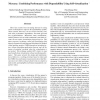Free Online Productivity Tools
i2Speak
i2Symbol
i2OCR
iTex2Img
iWeb2Print
iWeb2Shot
i2Type
iPdf2Split
iPdf2Merge
i2Bopomofo
i2Arabic
i2Style
i2Image
i2PDF
iLatex2Rtf
Sci2ools
ICPP
2007
IEEE
2007
IEEE
Mercury: Combining Performance with Dependability Using Self-virtualization
There has recently been increasing interests in using system virtualization to improve the dependability of HPC cluster systems. However, it is not cost-free and may come with some performance degradation, uncertain QoS and loss of functionalities. Meanwhile, many virtualizationenabled features such as online maintenance and fault tolerance do not require virtualization being always on. This paper proposes a technique, called self-virtualization, that supports dynamically attaching and detaching a full-fledged virtual machine monitor (VMM) beneath an operating system, without disturbing applications thereon, and rid the system of potential overhead when the virtualization is not needed. This technique enables HPC clusters to reap most benefits from virtualization without sacrificing performance. This paper presents the design and implementation of Mercury, a working prototype based on Linux and Xen VMM. Our performance measurement shows that Mercury incurs very little overhead: abo...
Distributed And Parallel Computing | HPC Cluster Systems | Hpc Clusters | ICPP 2007 | Performance Degradation |
Related Content
| Added | 03 Jun 2010 |
| Updated | 03 Jun 2010 |
| Type | Conference |
| Year | 2007 |
| Where | ICPP |
| Authors | Haibo Chen, Rong Chen, Fengzhe Zhang, Binyu Zang, Pen-Chung Yew |
Comments (0)

